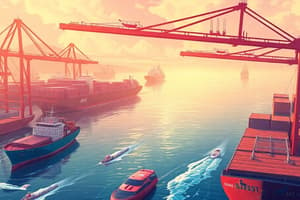Podcast
Questions and Answers
Which of the following is NOT a benefit of free trade?
Which of the following is NOT a benefit of free trade?
- Higher prices for consumers (correct)
- Lower prices due to competition
- Efficient allocation of resources
- Greater variety of goods
Governments utilize trade restrictions such as tariffs and non-tariff barriers (NTBs) to meet their economic goals.
Governments utilize trade restrictions such as tariffs and non-tariff barriers (NTBs) to meet their economic goals.
True (A)
What is the primary argument economists use to support free trade?
What is the primary argument economists use to support free trade?
It leads to efficient resource allocation based on comparative advantage.
A _______ is a tax imposed on imported goods to increase their price and protect domestic industries.
A _______ is a tax imposed on imported goods to increase their price and protect domestic industries.
Match the following trade restriction types with their descriptions:
Match the following trade restriction types with their descriptions:
What is the primary purpose of a tariff?
What is the primary purpose of a tariff?
Non-Tariff Barriers (NTBs) include import quotas and subsidies.
Non-Tariff Barriers (NTBs) include import quotas and subsidies.
What does the Effective Rate of Protection (ERP) measure?
What does the Effective Rate of Protection (ERP) measure?
A _____ is a tax on imported goods used to raise their price and protect domestic industries.
A _____ is a tax on imported goods used to raise their price and protect domestic industries.
Match the following types of tariffs with their definitions:
Match the following types of tariffs with their definitions:
Which of the following is NOT an objective of trade policy?
Which of the following is NOT an objective of trade policy?
The imposition of tariffs generally leads to a decrease in domestic production.
The imposition of tariffs generally leads to a decrease in domestic production.
What are two arguments for trade protection?
What are two arguments for trade protection?
Flashcards
Free Trade Benefits
Free Trade Benefits
Free trade leads to resource efficiency, lower prices for consumers, and more product variety.
Comparative Advantage
Comparative Advantage
The principle that countries should specialize in producing goods they can produce most efficiently.
Trade Restrictions
Trade Restrictions
Government policies (like tariffs) that limit international trade.
Tariffs
Tariffs
Signup and view all the flashcards
Trade Wars
Trade Wars
Signup and view all the flashcards
Trade Policy
Trade Policy
Signup and view all the flashcards
Ad Valorem Tariff
Ad Valorem Tariff
Signup and view all the flashcards
Non-Tariff Barrier (NTB)
Non-Tariff Barrier (NTB)
Signup and view all the flashcards
Import Quota
Import Quota
Signup and view all the flashcards
Infant Industry Argument
Infant Industry Argument
Signup and view all the flashcards
Effective Rate of Protection (ERP)
Effective Rate of Protection (ERP)
Signup and view all the flashcards
Specific Tariff
Specific Tariff
Signup and view all the flashcards
Study Notes
International Trade Strategy and Policy
- Trade Policy: Government actions influencing international trade flows. Goals include protecting domestic industries, promoting exports, maintaining a favorable balance of trade, and supporting economic development.
Tariffs
- Definition: Taxes on imported goods, raising prices and safeguarding domestic industries.
- Types:
- Ad valorem: Percentage of the imported good's value.
- Specific: Fixed amount per unit of the imported good.
- Compound: Combination of ad valorem and specific tariffs.
- Effects: Increased domestic production, reduced imports, higher government revenue, higher consumer prices, and inefficient resource allocation.
- Consumer and Producer Surplus: Tariffs reduce consumer surplus due to higher prices and increase producer surplus due to reduced competition.
Non-Tariff Barriers (NTBs)
- Definition: Measures besides tariffs that restrict imports or promote exports.
- Examples:
- Import quotas: Limits on the quantity of imported goods.
- Subsidies: Financial support for domestic producers.
- Technical barriers: Standards and regulations hindering foreign goods.
Effective Rate of Protection (ERP)
- Definition: Measures the level of protection provided to an industry, considering tariffs on both final goods and inputs.
- Formula: ERP = (Value added with protection - Value added without protection) / Value added without protection.
- Significance: ERP can exceed nominal tariffs if inputs are taxed at lower rates than final goods.
Arguments for Trade Protection
- Economic:
- Infant industry argument: Temporary protection for developing industries.
- Job protection: Preventing industries from losing jobs to foreign competition.
- Strategic trade policy: Supporting industries with long-term benefits.
- Non-economic:
- National security: Protecting defense-related industries.
- Cultural preservation: Safeguarding cultural industries.
Arguments for Free Trade
- Benefits: Efficient resource allocation, lower consumer prices, greater variety of goods and services.
Trade Restrictions in Practice
- Methods: Governments combine tariffs, NTBs, and sometimes subsidies.
- Potential Outcomes: Trade restrictions can lead to retaliatory measures and trade wars, negatively affecting global trade.
Studying That Suits You
Use AI to generate personalized quizzes and flashcards to suit your learning preferences.
Description
Test your knowledge on international trade strategies, including tariffs and non-tariff barriers. Understand how government policies influence trade flows and their impact on domestic industries. This quiz covers key concepts, definitions, and types of tariffs essential for comprehending trade policies.




